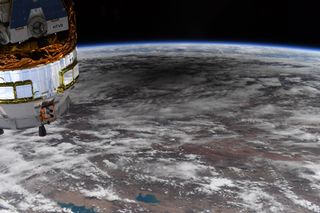See the moon's shadow on Earth from the 'ring of fire' solar eclipse in amazing space views
Astronauts and satellites captured the stunning images.
A "ring of fire" solar eclipse crossed over Africa and Asia this weekend, and the view from space was spectacular.
A NASA astronaut living and working in space and a host of weather satellites all spotted the dramatic event as the moon's shadow passed over Earth's surface. Although the solar eclipse wasn't visible from North America, it did happen to coincide with the U.S. celebration of Father's Day on June 21.
"Super cool view of the Annular Solar Eclipse which passed by our starboard side as we flew over China this morning," NASA astronaut Chris Cassidy wrote on Twitter. "A pretty neat way to wake up on Father's Day morning! Hoping all of the dads in the world have a wonderful day!"
Related: 'Ring of fire' solar eclipse of 2020 wows skywatchers across Africa, Asia

A "ring of fire" or annular eclipse occurs when the moon passes between the sun and Earth. But, unlike during a total solar eclipse, the moon isn't close enough to Earth to block out all of the sun's visible disk.
Instead, a thin ring of the sun's disk remains visible around the moon's shadow even at the midpoint of the eclipse, hence the phenomenon's nickname.
Super cool view of the Annular Solar Eclipse which passed by our starboard side as we flew over China this morning. A pretty neat way to wake up on Father's Day morning! Hoping all of the dads in the world have a wonderful day! #Eclipse #FathersDay #HappyFathersDay2020 pic.twitter.com/vJx5yOFAcbJune 21, 2020
But from space, an annular eclipse appears very similar to a total solar eclipse, and astronauts and satellites can spot the phenomenon by looking for a round shadow dancing across Earth's surface.
Get the Space.com Newsletter
Breaking space news, the latest updates on rocket launches, skywatching events and more!
That's precisely what Cassidy saw from his vantage point as one of five astronauts living and working on the International Space Station, where he arrived in April. At the time, the space station was passing about 250 miles (400 kilometers) above Earth's surface.
Российский космический аппарат #ЭлектроЛ № 2 с высоты 36 000 км запечатлел прохождение тени по поверхности Земли от кольцевого солнечного затмения, которое состоялось 21 июня ☀#затмение2020 #затмение #солнечноезатмение pic.twitter.com/akVyRNXoA6June 22, 2020
Other space views of the eclipse show a much higher-altitude recap of what occurred. Russia's Elektro-L No.2 weather satellite spotted an interplay of shadows during the event, for example.
The satellite, which launched in 2015 and is one of three identical monitoring stations, was orbiting at an altitude of 22,000 miles (36,000 km), according to a statement from the Russian space agency Roscosmos.
#SATELLITE SPOTLIGHT: The first day of #AstronomicalSummer started with an #AnnularEclipse! In this #Himawari8🛰️ loop, you can see the shadow of the #Moon pass over eastern #Asia. This kind of #eclipse appears as a #RingofFire in the sky, which was seen from #Africa to #Taiwan. pic.twitter.com/cIhyk4cqzbJune 21, 2020
Other weather satellites got in on the eclipse-watching action as well. Japan's Himawari-8 satellite and Europe's Meteosat-8 each followed the moon's shadow across Asia and Africa.
Here's some #MondayMotivation for you this morning—another view of yesterday's annular #SolarEclipse courtesy of #Meteosat8, operated by our partners @EUMETSAT. This type of #eclipse occurs when the moon passes in front of the sun, but doesn't completely cover it. pic.twitter.com/y0ArDEjc1mJune 22, 2020
- Amazing solar eclipse pictures from around the world
- 'Ring of fire' solar eclipse 2020: Here's how it works (and what to expect)
- NASA's best Earth-from-space photos by astronauts (gallery)
Email Meghan Bartels at mbartels@space.com or follow her @meghanbartels. Follow us on Twitter @Spacedotcom and on Facebook.
OFFER: Save 45% on 'All About Space' 'How it Works' and 'All About History'!
For a limited time, you can take out a digital subscription to any of our best-selling science magazines for just $2.38 per month, or 45% off the standard price for the first three months.
Join our Space Forums to keep talking space on the latest missions, night sky and more! And if you have a news tip, correction or comment, let us know at: community@space.com.

Meghan is a senior writer at Space.com and has more than five years' experience as a science journalist based in New York City. She joined Space.com in July 2018, with previous writing published in outlets including Newsweek and Audubon. Meghan earned an MA in science journalism from New York University and a BA in classics from Georgetown University, and in her free time she enjoys reading and visiting museums. Follow her on Twitter at @meghanbartels.

